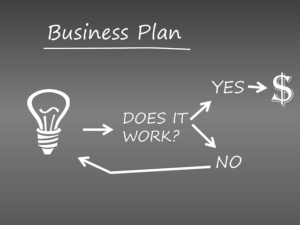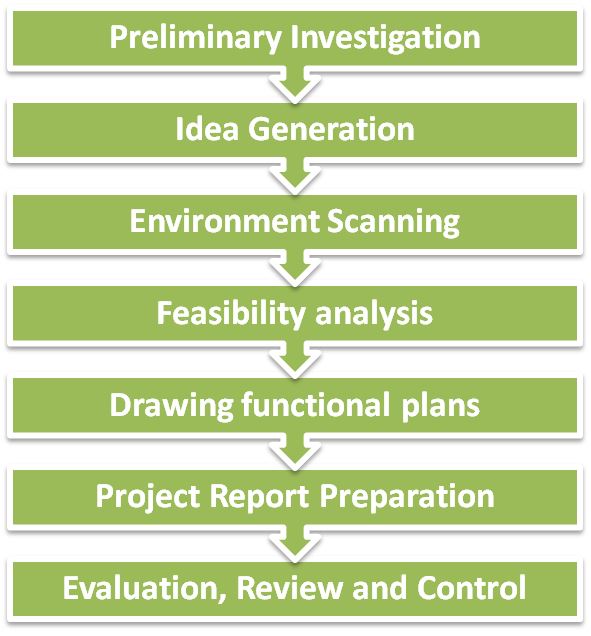Business Plan
 A Business Plan is a blueprint of the step by step procedure that would be followed in order to convert a business idea into a successful business venture. It involves the following tasks –
A Business Plan is a blueprint of the step by step procedure that would be followed in order to convert a business idea into a successful business venture. It involves the following tasks –
- Identifying business opportunities and an innovative idea
- Researching the external environment for opportunities and threats
- Identifying internal strengths and weaknesses
- Assessing the feasibility of that idea and
- Allocating resources in the best possible manner
Objectives of a Business Plan
- To give direction to the vision of Entrepreneur
- To objectively evaluate the future prospects of the business
- To monitor the progress after implementation of the plan
- To seek loans from Financial Institutions
- To facilitate the decision making process
- To persuade others to join the business
- To identify strengths and weaknesses present in the internal environment
- To identify opportunities and threats in the external environment
- To assess the feasibility of the business
Preparation of a Business Plan
A good business plan must identify strengths and weaknesses internal to the business and the challenges in terms of opportunities and threats to assess the viability of the business. It must lay down all the necessary steps that are involved in initiating and operating a proposed business. Preparation of a business plan involves the following steps :-
(I) Preliminary Investigation – In order to create an effective plan an entrepreneur must –
- Review available business plans
- Draw key business assumptions on which plan is based
- Scan the environment for Strengths, Weaknesses, Opportunities and Threats
- Seek professional advice
- Conduct a functional audit
(II) Idea Generation – It involves generation of a new concept/product/service or value addition to an existing Product or Service. The idea must be such that satisfies the existing demands and future demands of market.
Sources of ideas –
- Consumers
- Existing companies
- Research & Development
- employees
- Dealers/Retailers
Methods of generating ideas –
- Brain storming
- Group discussion
- Data collection through questionnaires
- Invitation of ideas from professionals
- Value addition to existing Product and Service
- Market research
- Import of ideas from products launched abroad
- Commercializing inventions
Screening of ideas is done to identify practical ones and eliminate impractical one. The most feasible and the most promising idea is selected for further investigation.
(III) Environment Scanning – The internal and external environment must be analysed to study the prospective strengths, weaknesses, opportunities and threats of the business. An entrepreneur must collect information from all formal and informal sources in order to understand the supportive and obstructive factors related to the business enterprise.
External Environment –
• Socio cultural appraisal – It involves assessment of the values, beliefs and norms of a particular society in order to understand their perception towards a particular idea or product.
• Technological appraisal – It involves assessment of existing technical know-how and availability of technology necessary to convert an idea into a product.
• Economic appraisal – It assess the economic environment in terms consumer price index, inflation, balance of payments, consumption pattern, per capita income etc.
• Demographic – It involves an assessment of the overall population pattern of a particular region. Variables like age, education, income pattern, sex, occupation, distribution etc. help in identifying the size of target market.
• Government appraisal- It assess various grants, legislations, policies, incentives, subsidies etc. formed by government.
Internal Environment –
- Availability of Raw materials
- Availability of various machines, tools and equipment required for production
- Means of Finance and assessment of opening, maintaining and operating expenses
- Assessment of Present, Potential and Future market
- Assessment of cost, quantity and quality of human resources required
(IV) Feasibility analysis – Feasibility analysis is done to find out whether the proposed project will be feasible or not. The various variables that are studied include –
(a) Market Analysis – It is conducted to –
- Estimate the demand of the proposed product in the future
- Estimate the market share of the proposed product in the future
(b) Technical or operational analysis – It is conducted to access the operational ability of the proposed business. It is very important to find out the cost and availability of technology. Under Technical analysis data is collected on following parameters –
- Material availability
- Material requirement planning
- Plant location
- Plant capacity
- Machinery and Equipment
- Plant layout
(C) Financial analysis – A Financial Feasibility test is carried out to access the financial issues related with the proposed business. The following estimates have to be carried out –
- Cost of land and building
- Cost of plant and machinery
- Preliminary cost estimation
- Provision for contingencies
- Working capital estimates
- Cost of production
- Sales and production estimates
Based on the above analysis the following projections are made –
- Break-even point
- Cash flow statement
- Balance sheet
(V) Drawing functional plans – If the feasibility plans give a positive indication a draft business plan is formulated. It involves preparation of the following functional plans –
(a) Marketing Plan – A marketing plan lays down strategies for marketing a product/service which can lead to success of business. These strategies are made in terms of marketing mix (4 P’s) i.e. Product, Price, Place and Promotion.
(b) Production/Operation Plan –A production plan is made for a business involved in manufacturing industry while an operation plan is made for business involved in service industry. It includes strategies for following –
- Location and reasons for selecting a location
- Physical layout
- Cost and availability of equipment, machine and raw material
- List of suppliers and distributors
- Cost of manufacturing and running operations
- Quality management
- Production scheduling capacity and Inventory management
(c) Organizational Plan – It defines the type of ownership i.e. it could be a single proprietary, partnership firm, company, private limited or public limited. It also consists of details about the organization structure and norms guiding the organization culture.
(d) Financial Plan – It indicates the financial requirement of the proposed business and furnishes the following details –
- Cost incurred in smooth running of all the financial plans
- Projected cash flows
- Projected income statement
- Projected Break even point
- Projected ratios
- Projected balance sheet
(e) Human Resource Plan – It consists of the details on the following:-
- Manpower requirements
- Recruitment and Selection
- Compensation
- Organization structure
- Wages and Salaries
- Budget
- Remuneration etc.
(VI) Project Report Preparation – It is a written document that describes step by step, the strategies involved in starting and operating a business. It is prepared when environmental scanning has been done and feasibility studies have been carried out.
(VII) Evaluation, Review and Control – In order to keep up with the dynamic environment and successfully face global competition a business must be continuously evaluated and reviewed. It is necessary to periodically evaluate, control and review a business to keep up with the technological changes and introduce changes in the business strategy.

awsmmm business plan , contains enthausiastic
Example of an business plan document
As a senior business analyst, I am looking for tips to advance my career, especially in days of digital transformation and agile transformation.
Прямо здесь доступен сервис “Глаз Бога”, который проверить всю информацию по человеку из открытых источников.
Бот работает по номеру телефона, используя публичные материалы в Рунете. Благодаря ему осуществляется пять пробивов и глубокий сбор по фото.
Платформа обновлен согласно последним данным и поддерживает аудио-материалы. Глаз Бога гарантирует найти профили в открытых базах и отобразит информацию мгновенно.
https://glazboga.net/
Это бот — помощник для проверки людей удаленно.